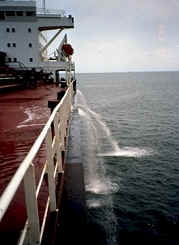

Ballast water discharges by ships can have a negative impact on the marine environment. The discharge of ballast water and sediments by ships is governed globally under the Ballast Water Management Convention, since its entry into force in September 2017. It is also controlled through national regulations, which may be separate from the Convention, such as in the United States.
Cruise ships, large tankers, and bulk cargo carriers use a huge amount of ballast water, which is often taken on in the coastal waters in one region after ships discharge wastewater or unload cargo, and discharged at the next port of call, wherever more cargo is loaded. Ballast water discharge typically contains a variety of biological materials, including plants, animals, viruses, and bacteria. These materials often include non-native, nuisance, and exotic species that can cause extensive ecological and economic damage to aquatic ecosystems, along with serious human health issues including death. Although similarly harmful to the environment, ballast water discharge is different than bilge pollution, which occurs when pollutants from a ship's heavy machinery leak into the ocean.